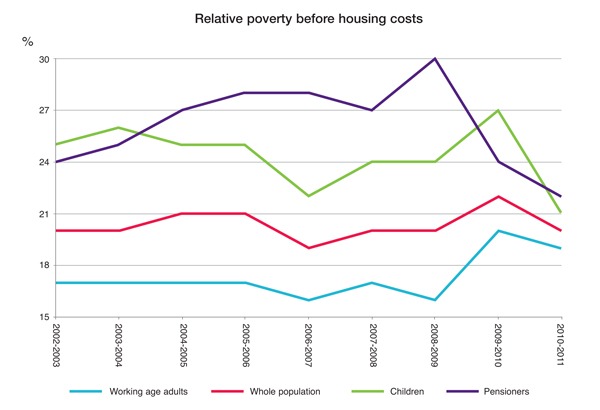Poverty levels in Northern Ireland
A new poverty bulletin shows that one-fifth of people are living in relative poverty and reports decreases in some forms of the problem.
The Department for Social Development has produced its first annual poverty bulletin and reported that relative poverty (before housing costs are factored in) fell from 22 per cent to 20 per cent of the population during 2010-2011. The decline is based on data from the UK-wide Family Resources Survey.
Thirteen per cent of people were in absolute poverty, unchanged from 2009-2010. These statistics represent 355,100 people in relative poverty and 231,700 in absolute poverty.
Minor year-on-year changes must be interpreted cautiously, however. Trends are evident by looking at data for several years. The table below shows that while relative poverty among the general population has not changed greatly over nine years, it has fallen among pensioners and children. The proportion of working age adults in relative poverty has increased slightly.
Relative poverty is defined as living in a household where equivalised income (adjusted to reflect different household size and composition) is below 60 per cent of the UK median income in the same year.
Among children, there was a steep decline in relative poverty during 2010-2011. It fell by six percentage points, from 27 per cent to 21 per cent. 93,000 children remained in relative poverty. 58,500 children (13 per cent) were in absolute poverty, 1 per cent higher than in 2009-2010. Absolute poverty is defined as living in a household with an equivalised income level 60 per cent below the inflation-adjusted median income in Great Britain in 1998-1999.
The proportion of pensioners in poverty continues to decline. With 62,800 in relative poverty, 2010-2011 saw a decrease from 24 per cent to 22 per cent. In 2009-2010, it was 30 per cent. Absolute poverty stood at 13 per cent during 2010-2011. This was down 1 per cent on 2009-2010 and 7 per cent on 2008-2009. 37,400 pensioners are in this situation.
Among the working population, relative poverty fell from 20 per cent to 19 per cent in 2010-2011; absolute poverty increased by one percentage point (12 per cent to 13 per cent).
Another measurement of relative and absolute poverty, income after housing costs are excluded, shows a 3 per cent drop in relative poverty (to 20 per cent) and a 2 per cent increase in absolute terms (to 14 per cent) among the whole population during 2010-2011.






